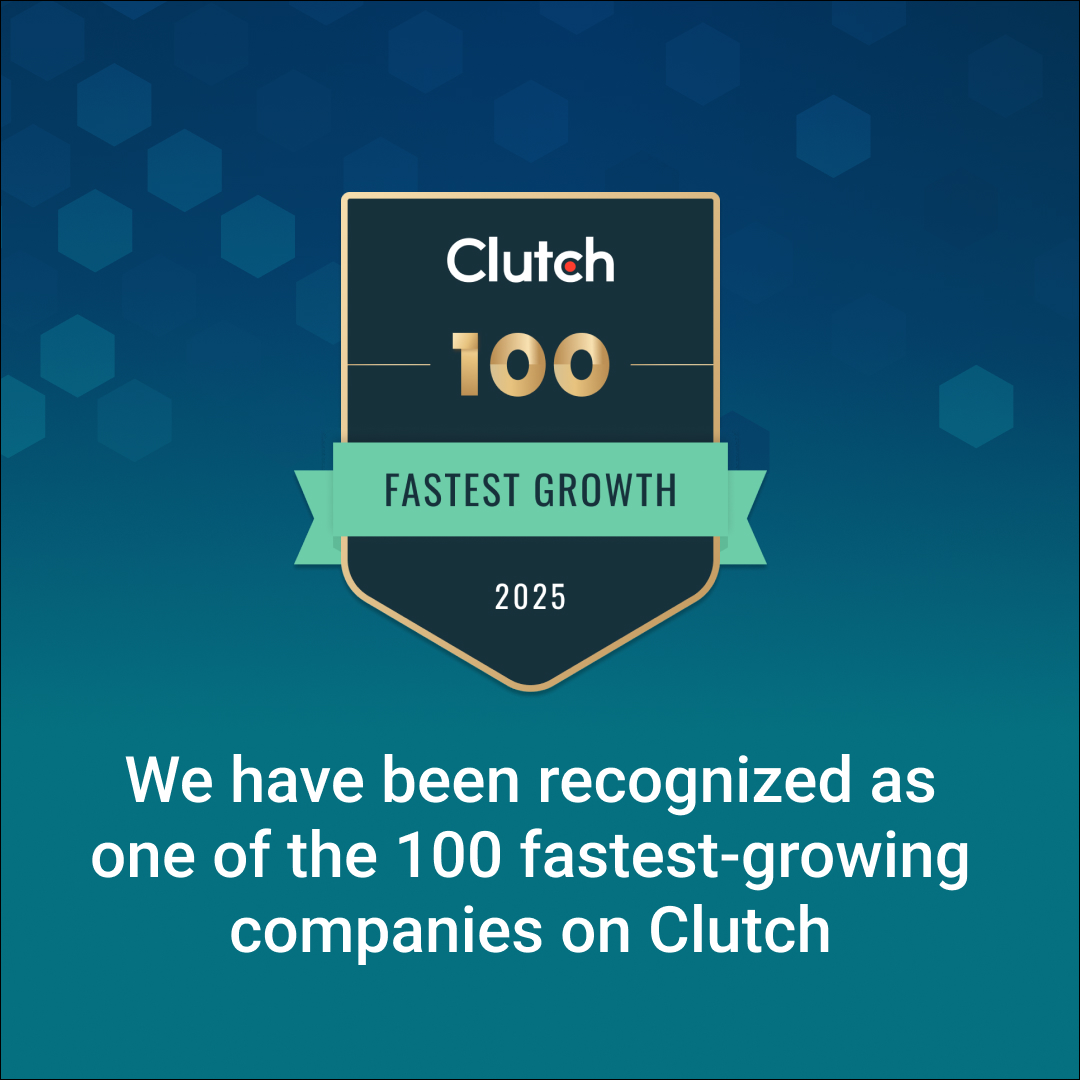Einführung
As AI reshapes the software development landscape, the role of tech lead is evolving just as rapidly. Beyond overseeing architecture and delivery, Sie sind now expected to lead intelligent transformation across teams and systems. Thriving in this new era calls for more than technical Sachverstand, it demands vision, adaptability, and the ability to turn disruption into opportunity.
What is AI and Why Tech Lead Must Embrace AI?
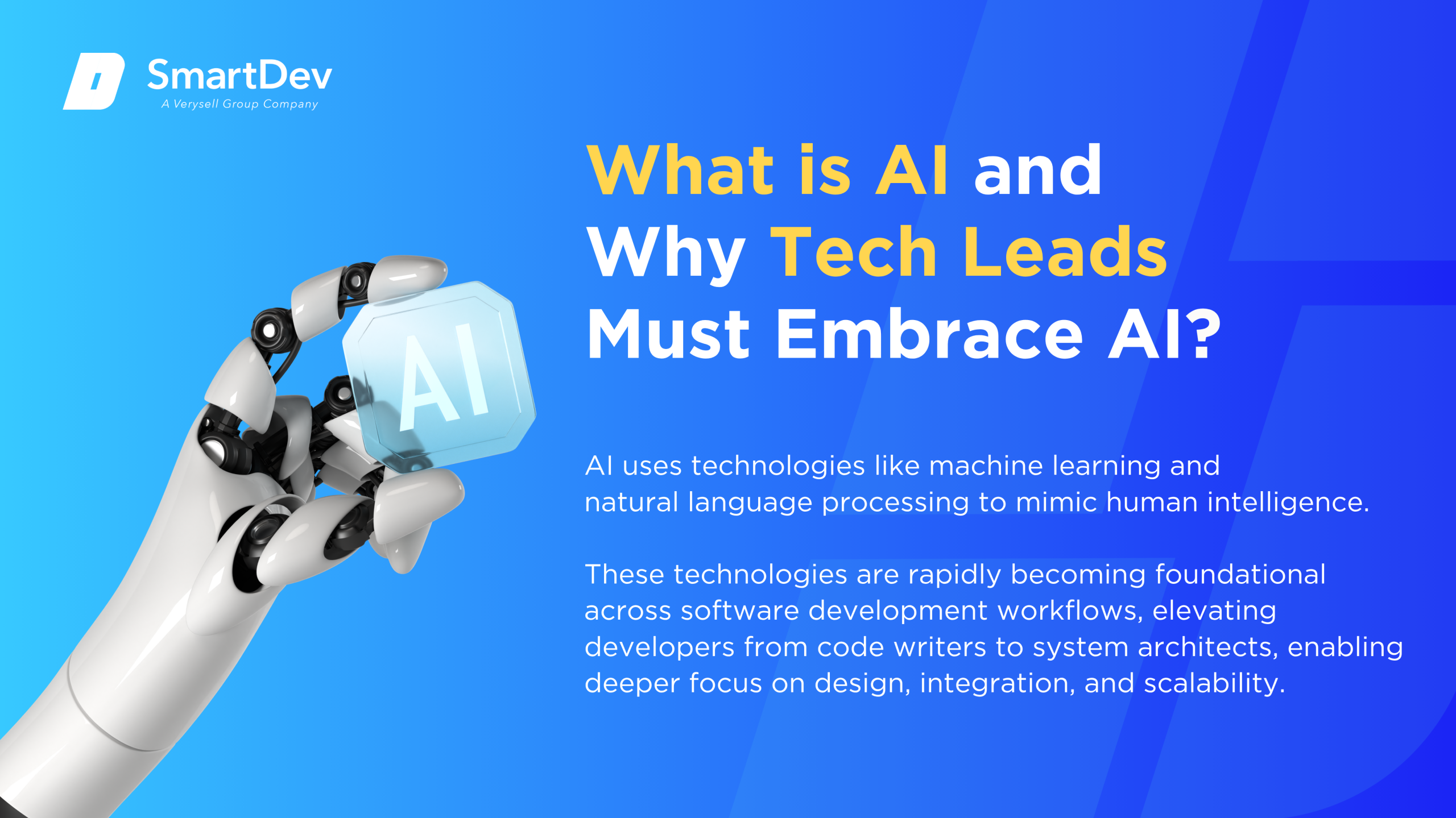
Artificial Intelligence (AI) refers to the ability of machines and systems to perform tasks that typically require human intelligence. This includes learning from data (machine learning), understanding language (natural language processing), recognizing patterns (computer vision), and making decisions in real time. These technologies are rapidly becoming foundational across software development workflows.
The strategic role of AI in software development and DevOps
AI plays a strategic role in software development and by automating repetitive tasks, allowing developers to concentrate on innovation and higher-order problem-solving. Intelligent tools can generate code, detect bugs, and automate testing, which accelerates development cycles and enhances overall code quality. This shift elevates developers from code writers to system architects, enabling deeper focus on design, integration, and scalability.
To dive deeper into real-world examples of how AI is transforming the development lifecycle, explore our full breakdown of AI use cases in software development.
In DevOps, AI optimizes workflows through intelligent automation and predictive analytics, reducing manual errors and speeding up deployments. It enhances resource management, refines time estimation, and streamlines CI/CD pipelines for more consistent software delivery. By leveraging real-time and historical data, AI enables proactive issue detection and resolution, improving operational efficiency and system reliability.
For a deeper look at how streamlined deployment pipelines and infrastructure automation can accelerate AI adoption, explore SmartDev’s comprehensive DevOps-as-a-Service solutions.
Key Statistics or Trends Highlighting AI Adoption
AI is rapidly becoming a cornerstone of enterprise technology strategy. According to McKinsey’s 2025 State of AI global survey, 78% of organizations have adopted AI in at least one business function, with software engineering, marketing, and customer operations leading the way – a jump from 55% in 2023.
When examining investment and returns, McKinsey highlights that 65% of organizations regularly use generative AI, reflecting its growing role in strategic workflows. Further, their H1 2024 survey revealed that 46% of software engineering functions reported increased revenue following AI deployment, with over 46% seeing cost reductions as well.
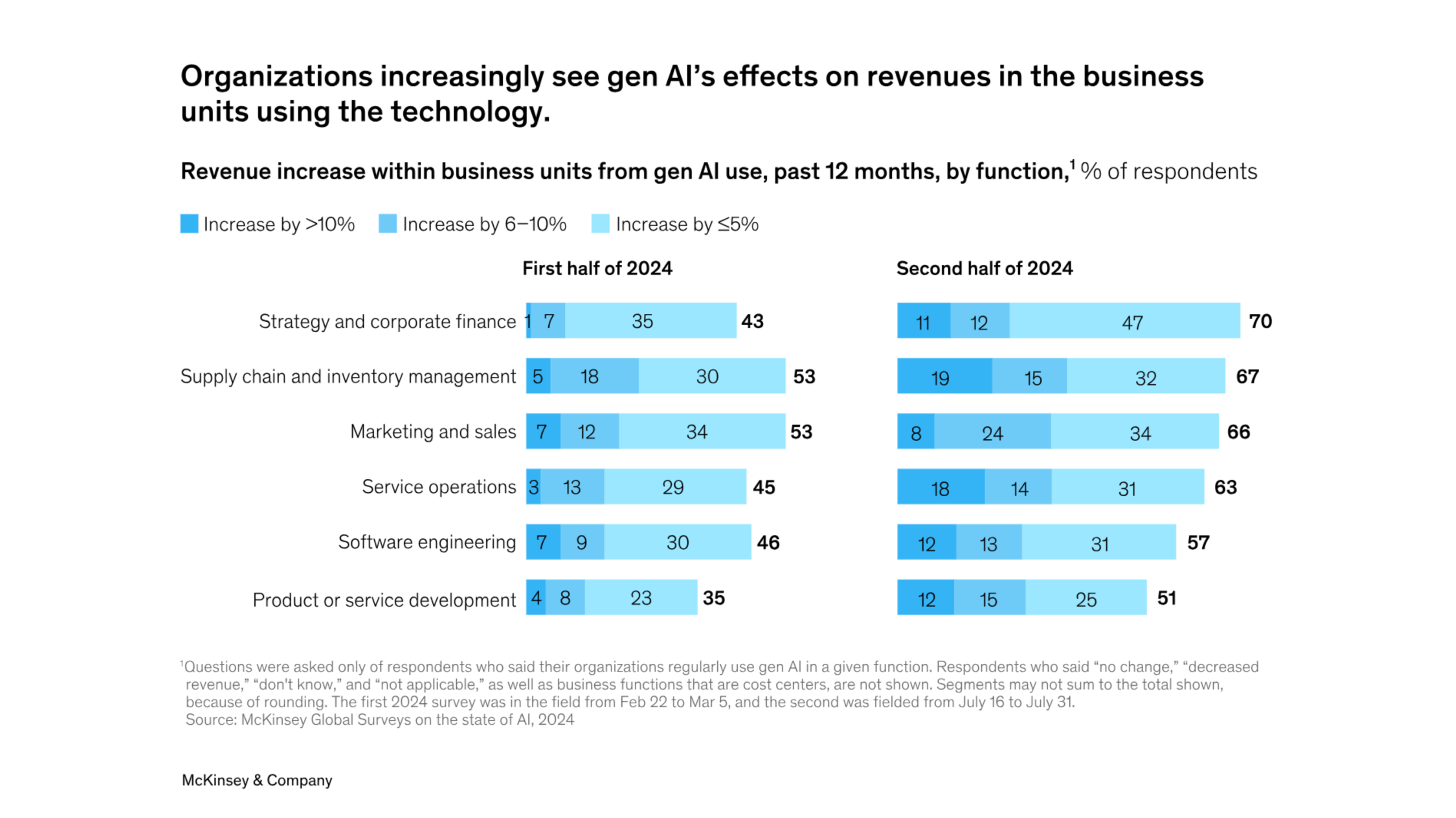
Quelle: McKinsey & Company
Budget trends reflect AI’s growing influence on tech strategy. According to AWS’s Generative AI Adoption Index, 45% of IT leaders rank AI as their top budget priority for 2025, surpassing even cybersecurity at 30%. Gartner forecasts global spending on generative AI to reach $644 billion by 2025 – a 76.4% increase from 2024, underscoring the scale of investment now driving the AI era.
Benefits of AI Adoption for Engineering Organizations
AI is transforming the core mechanics of software development, offering concrete advantages for engineering leaders navigating increasing complexity and scale. By integrating AI strategically, teams can unlock measurable gains in velocity, quality, and system resilience.
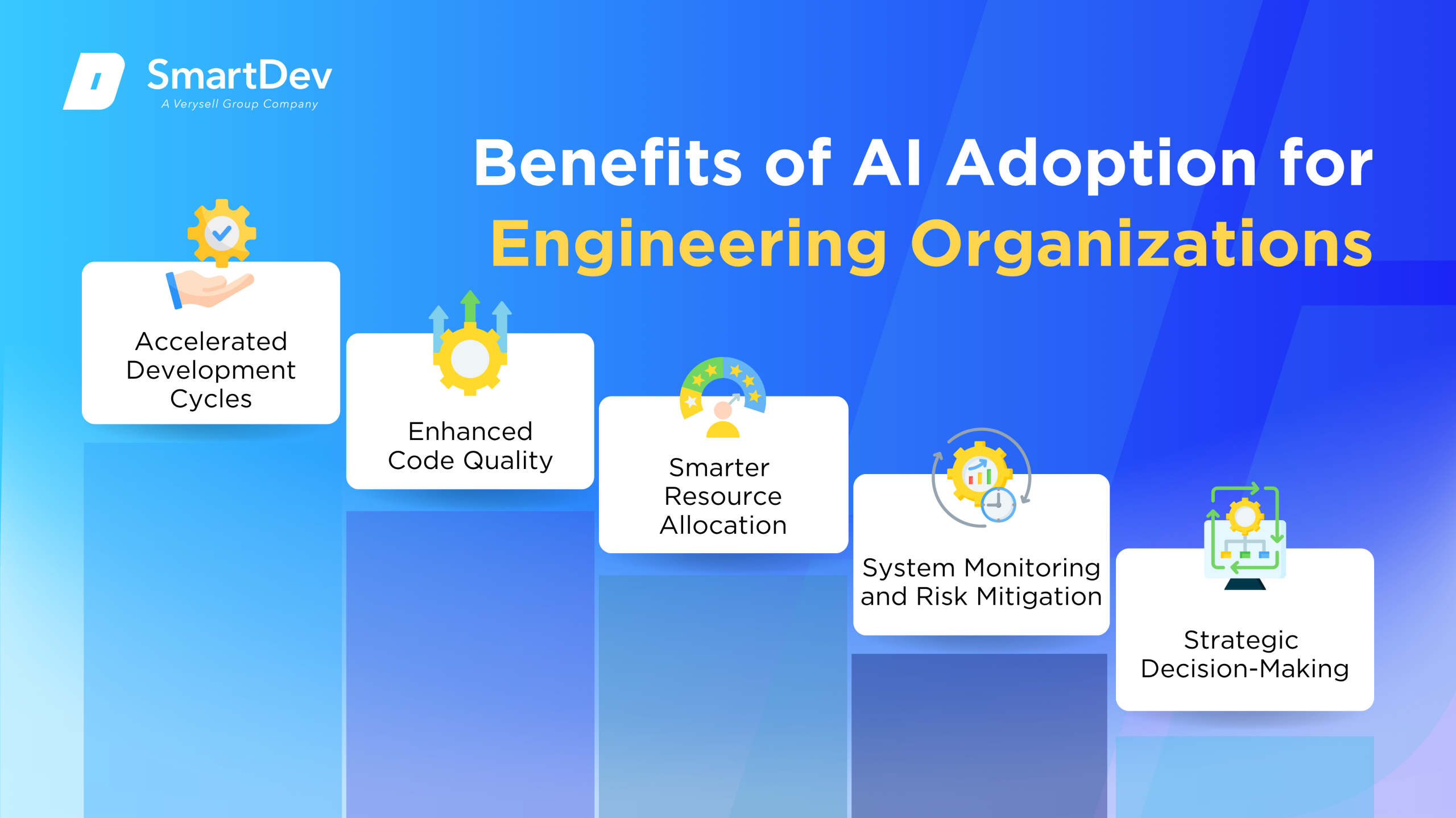
1. Accelerated Development Cycles
AI dramatically shortens software development timelines by automating code generation, testing, and debugging. This reduces the manual burden on developers, allowing teams to deliver features faster while maintaining high-quality standards. With less time spent on repetitive tasks, engineers can focus more on architecture, scalability, and user-centric design.
Beyond speed, faster cycles promote more iterative, experimental development. This agility allows organizations to respond quickly to user feedback and evolving business needs. For tech lead, faster delivery means a sharper competitive edge and stronger stakeholder trust.
2. Enhanced Code Quality and Reliability
AI tools improve software reliability by detecting bugs, suggesting code improvements, and enforcing consistent coding standards. These systems learn from large-scale codebases to identify security flaws and inefficiencies that may be missed by manual review. As a result, teams release software with fewer defects and greater confidence.
More reliable code leads to fewer incidents in production, reducing operational overhead and customer disruption. Over time, quality improvements compound, minimizing technical debt and improving maintainability across systems.
3. Smarter Resource Allocation
AI enables more accurate forecasting of project timelines, workload distribution, and resource needs. By analyzing historical data and real-time metrics, teams can plan sprints more effectively, reducing bottlenecks and underutilization. This transforms resourcing from intuition-led to data-driven.
Improved allocation also promotes team well-being. By balancing workloads and surfacing early warning signs of overload, leaders can reduce burnout and foster sustainable velocity over time.
4. Proactive System Monitoring and Risk Mitigation
AI-powered observability tools detect anomalies and performance degradation before they affect users. These systems analyze logs, metrics, and traces to surface actionable insights, enabling proactive incident response and automated remediation. This strengthens platform resilience and uptime.
For engineering leadership, this means shifting from reactive firefighting to predictive operations. By minimizing downtime and service interruptions, teams can uphold SLAs and enhance user satisfaction.
5. Strategic Decision-Making with Real-Time Insights
AI provides leaders with real-time dashboards, trend analysis, and scenario modeling to inform decision-making. Whether it’s identifying high-impact features, estimating ROI, or prioritizing tech debt, data-backed insights replace gut feeling. This improves strategic alignment and accountability across initiatives.
With enhanced visibility, tech lead can guide their teams with clarity, communicate effectively with executives, and adapt strategies quickly as priorities shift. AI transforms leadership from responsive to visionary.
To effectively harness AI, organizations need a solid data foundation, learn how SmartDev’s Data Analytics Services help transform raw data into actionable insights that power intelligent decision-making.
Common Challenges in AI Adoption for Tech Lead
While the promise of AI is compelling, its adoption often comes with significant hurdles that can slow progress or limit impact. Recognizing these barriers is key to driving successful implementation.
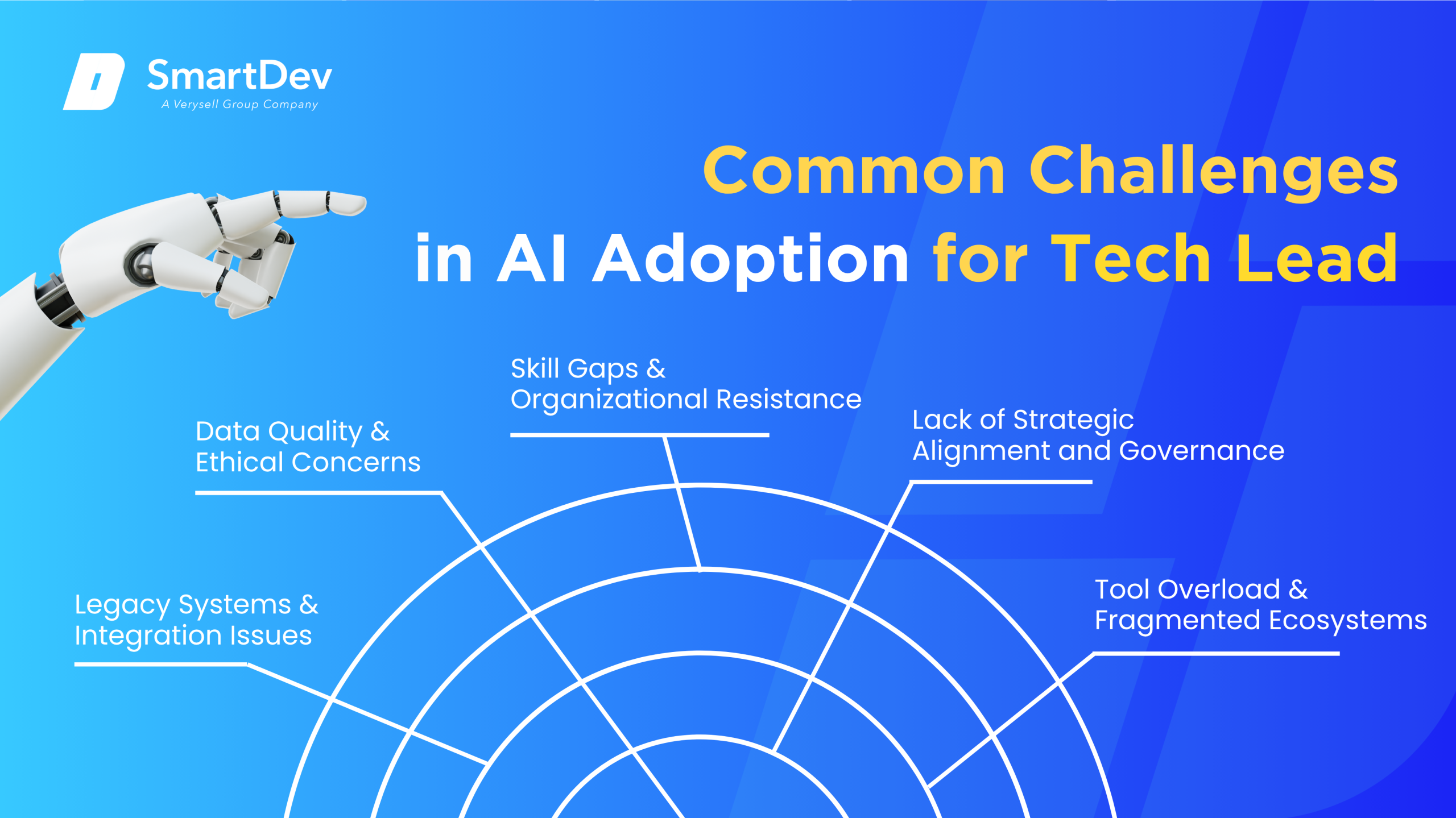
1. Legacy Systems and ICHIntegration ICHssues
Many enterprises still rely on legacy infrastructure that wasn’t built to support modern AI applications. These systems often lack compatibility with real-time data pipelines, cloud-native tools, and APIs required for AI integration. As a result, integrating AI into production environments becomes a costly, slow, and technically complex process.
Beyond the technical hurdles, legacy systems can create organizational inertia. Teams may be hesitant to invest in overhauling stable but outdated environments. Tech lead must champion gradual modernization strategies that balance short-term needs with long-term AI-readiness.
2. Daten Quality and Ethical Concerns
AI systems are only as good as the data they are trained on. Inconsistent, biased, or incomplete data can lead to inaccurate predictions and unintended outcomes—raising both ethical and operational concerns. This erodes trust in AI and can undermine its value across the organization.
In addition to data quality, ethical concerns such as fairness, transparency, and accountability must be proactively addressed. AI decisions can have serious implications, particularly in customer-facing or regulated domains. Establishing clear data governance and responsible AI frameworks is essential from the outset.
3. Skill Gaps and Organizational Resistance
Many organizations face a shortage of professionals with the technical and strategic skills required to deploy and manage AI effectively. Even when tools are available, teams may lack the confidence or training to use them productively. This skills gap slows adoption and increases reliance on external consultants or vendors.
Resistance also stems from fear of disruption or job displacement. Employees may feel threatened by automation or unclear about how AI fits into their roles. Tech lead must bridge this gap through transparent communication, continuous learning programs, and inclusive implementation strategies.
4. Mack of Strategic Alignment and Governance
Without a clear connection between AI projects and business goals, initiatives often remain siloed and fail to deliver meaningful outcomes. When AI is seen as a side experiment rather than a strategic investment, it rarely receives the support needed to scale. This results in wasted resources and diminished impact.
Strong governance is also lacking in many organizations adopting AI at speed. Without policies for risk management, compliance, and oversight, AI systems can introduce unintended consequences. Tech lead must align efforts across stakeholders and establish robust governance to ensure consistent, value-driven adoption.
5. Tool Overload and Fragmented AI Ecosystems
As interest in AI grows, organizations often deploy multiple tools across teams and use cases, leading to fragmented ecosystems. Each tool may come with its own workflows, requirements, and integration constraints, making it difficult to maintain efficiency or consistency. This complexity can slow down innovation and create technical debt.
Fragmentation also limits collaboration and knowledge sharing, as teams become isolated around specific platforms. The lack of a unified approach hinders strategic scalability and introduces risks related to versioning, monitoring, and governance. Tech lead must evaluate tools through a long-term lens, prioritizing platform interoperability and centralized oversight.
AI in Action: Practical Use Cases for Tech Mead
AI is rapidly becoming a critical enabler of modern software engineering, offering tangible gains in speed, quality, and operational efficiency. For technical leaders, knowing where and how to apply AI is key to staying competitive and turning emerging capabilities into lasting advantages.
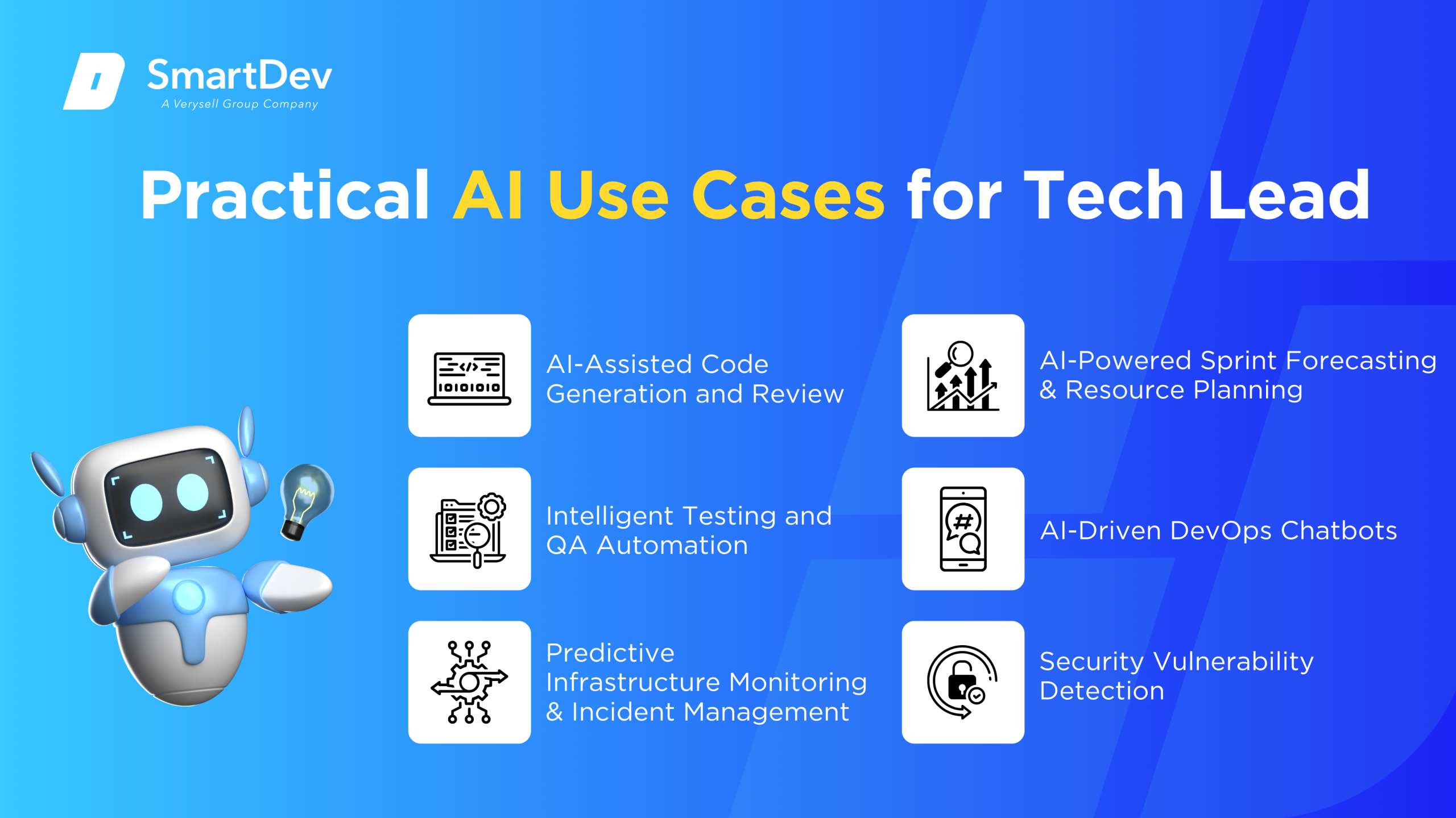
1. AI-Assisted Code Generation and Review
AI copilots within IDEs offer contextual code suggestions, detect bugs, and produce documentation automatically. This streamlines developer workflows and enforces consistent coding patterns across teams. Over time, engineers transition from crafting every line of code to orchestrating system architecture and validating AI-generated content.
Deep learning models trained on extensive codebases enable these assistants to produce syntactically correct and semantically relevant suggestions. Integration into platforms like Visual Studio Code supports seamless usage without disrupting existing IDE setups. This makes AI-enhanced coding an extension of developers’ regular workflow.
By reducing manual effort and cognitive load, these tools speed up delivery and elevate code quality. Teams can focus on evaluating complexity and maintaining standards rather than writing redundant code. However, AI suggestions still require human review to ensure security and correctness.
Real-world Example: A study by Accenture found that over 80% of developers adopted GitHub Copilot, with 67% using it at least five days per week and 90% reporting higher satisfaction with their work.
2. Intelligent Testing and QA Automation
Machine learning–based test platforms generate and maintain testing scripts, adapting automatically to evolving UI or backend changes. This self-healing capability reduces test flakiness and frees QA teams from repetitive updates. Consequently, teams can focus effort on exploratory and edge-case testing.
These platforms use reinforcement learning and historical test data to anticipate and correct failures in test sequences. By integrating into CI/CD pipelines, they ensure assignments stay relevant and resilient. This increases confidence in releases while preserving agile velocity.
As coverage improves, teams deliver features faster without compromising quality. QA becomes more strategic rather than script-driven. Yet, it remains important to validate test intent and manage scope continuously.
Real-world Example: Sensormatic Solutions achieved 96% test coverage with Mabl, reducing production bugs by around 50% and cutting test creation time from a week to a single day.
3. Predictive Infrastructure Monitoring & Incident Management
AI-observability systems analyze telemetry data like logs and metrics to detect anomalies and forecast incidents proactively. Automated remediation, such as scaling services or restarting processes, reduces system disruption before it impacts users. This enables engineering teams to shift from refighting to resilience-focused operations.
These solutions rely on unsupervised learning and time-series analysis to identify performance deviations and root causes. Connected to cloud and on-prem infrastructure, they enable end-to-end visibility and remediation suggestions. This supports continuous improvement in system stability.
By minimizing operational noise and downtime, reliability rises while engineering teams concentrate on innovation. Engineering leaders receive insights that guide architecture optimization. Still, tuning and telemetry quality remain critical for precision.
Real-world Example: Dynatrace’s Davis AI helped BARBRI scale its Azure environment during peak demand, preventing downtime and maintaining performance.
4. AI-Powered Sprint Forecasting & Resource Planning
AI-enhanced planning tools use historical team data – velocity, ticket complexity, and delivery patterns – to forecast future sprint outcomes accurately. This transforms planning from guesswork to data-driven decision-making. Engineering teams adjust resources and expectations based on quantitative insights.
Methods include regression models and neural networks that analyze metadata from Jira or GitHub activity. These insights present workload imbalances or capacity risks before sprints begin. As a result, teams align scope with capacity more effectively.
Improved predictability fosters stakeholder trust and stabilizes delivery expectations. Leaders can proactively rebalance tasks and load across teams. Calibration challenges exist, but benefits in transparency are clear.
Real-world Example: A mid-size SaaS company using Jellyfish increased sprint predictability from 55% to 76.5%, saving 32 hours monthly.
5. AI-Driven DevOps Chatbots
Conversational AI in chat platforms enables developers and operators to interact naturally with DevOps systems, executing builds, checking logs, or querying deployment status. This reduces context switching and makes infrastructure data accessible to all roles. It fosters autonomy and speeds up decision-making.
These chatbots leverage NLP and webhook integrations to align commands with operational tools like CI/CD pipelines and observability services. They help streamline responses and embed best practices via prebuilt workflows. As a result, teams gain productivity and standardization.
Operational friction decreases, and collaboration improves through universal access to environment data. Development managers can encode operational guardrails in the bot. However, consistency and command accuracy require ongoing governance.
Real-world Example: An e-commerce team using AWS DevOps chatbot halved incident response times during high-traffic events.
6. AI-Based Security Vulnerability Detection
AI-driven security tools analyze code for vulnerabilities and insecure patterns using deep learning and graph-based models, identifying issues undetected by traditional scanners. These systems prioritize risk based on exploitability and access context. When integrated into CI/CD pipelines, they embed security into routine workflows.
Training on global code repositories enables detection of zero-day vulnerabilities and insecure dependencies. Developers receive actionable alerts with suggested fixes, enabling proactive defenses. As a result, security shifts left rather than appearing as a late-stage concern.
Teams reduce remediation time and improve compliance posture while continuing rapid development. Engineering leaders enforce secure-by-design practices. Still, noise management and tool oversight remain essential.
Real-world Example: Cresta reduced vulnerability alerts by over 99% using AI-based scanning from Endor Labs, focusing only on executed and relevant code paths.
Essential Traits and Skills for Tech lead in the Age of AI
As AI becomes embedded in every layer of the software development lifecycle, the role of technical leadership is evolving just as rapidly. To lead effectively in this new era, engineering leaders must cultivate a distinct set of skills that blend technical insight with strategic, ethical, and collaborative acumen.
1. Data Fluency and AI Literacy
In the age of AI, understanding data pipelines, model behavior, and statistical reasoning is no longer optional for technical leaders. While they may not need to build models themselves, they must be comfortable interpreting AI outputs, questioning model assumptions, and guiding teams on data relevance and readiness. This foundational fluency enables smarter decisions around tool selection, model performance, and resource allocation.
AI literacy also includes understanding the limitations of AI systems, such as bias, overfitting, or dependency on large datasets. Leaders must be able to translate technical outcomes into business implications and communicate AI capabilities and constraints clearly to stakeholders. This bridges the gap between abstract model performance and real-world application.
2. Strategic Thinking and Risk Mitigation
Technical leaders must evaluate where AI adds the most value, balancing innovation with feasibility. This requires strategic foresight, assessing business needs, prioritizing AI use cases, and aligning them with long-term goals. AI projects that lack strategic grounding often fail to scale or deliver ROI.
Risk mitigation is equally critical, as AI introduces new operational and reputational vulnerabilities. Leaders must anticipate challenges like model drift, data privacy issues, or regulatory changes. Proactively identifying and addressing these risks is what transforms experimentation into sustainable delivery.
3. Cross-functional Collaboration and Communication
AI implementation requires alignment between engineering, product, operations, legal, and leadership teams. Technical leaders must act as connectors, translating AI’s technical realities into cross-functional conversations. This ensures buy-in and coordinated execution across the organization.
Effective communication is not only about clarity but also about timing and audience awareness. Whether securing executive sponsorship or addressing concerns from compliance teams, leaders must tailor their message to each stakeholder. This ability to bridge technical and business domains accelerates adoption and minimizes friction.
4. Ethical Leadership in AI Deployment
With AI influencing decisions at scale, ethical leadership is no longer a soft skill, it’s a strategic necessity. Leaders must champion responsible AI practices, including fairness, transparency, and accountability. Ignoring these principles risks not only brand damage but also legal and operational consequences.
Ethical leadership involves creating guardrails that go beyond compliance. It means asking hard questions about unintended consequences, ensuring human oversight, and designing for inclusion and accessibility. Leaders who set these standards early build trust and credibility both internally and externally.
5. Adaptability and Continuous Learning
In a field evolving as quickly as AI, adaptability is a core leadership trait. Technical leaders must stay current with emerging tools, methodologies, and regulatory shifts to make informed decisions. Embracing a mindset of continuous learning enables them to pivot strategies as technologies and business needs evolve.
This adaptability should extend beyond personal growth to team culture. Leaders must foster an environment where experimentation is encouraged, failures are treated as learning opportunities, and knowledge is continuously shared. By modeling flexibility and curiosity, they help teams stay resilient and innovative in the face of constant change.
Strategic Framework for AI Adoption
Adopting AI at scale requires more than just choosing the right tools, it demands a clear, structured strategy aligned with business goals. A well-defined framework helps organizations move from experimentation to enterprise-wide impact with focus, speed, and accountability.
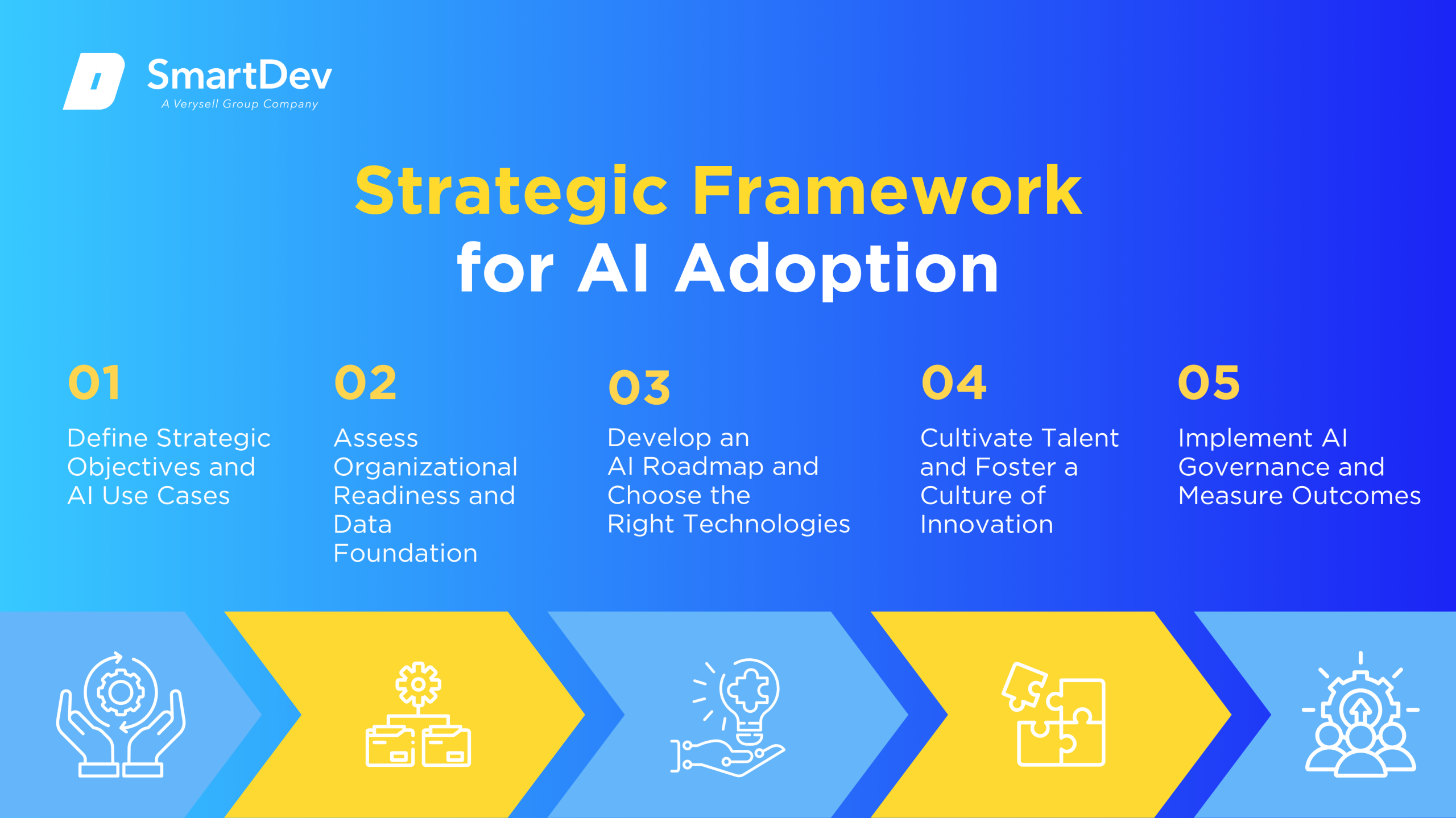
1. Define Strategic Objectives and AI Use Cases
Start by aligning AI initiatives with core business goals, whether improving efficiency, enhancing customer experience, or enabling new services. Engage with key stakeholders to identify specific challenges AI can solve, ensuring relevance and business impact. Clear problem definition prevents solution-first thinking and promotes strategic alignment.
Prioritize use cases using a value-versus-feasibility matrix to focus on what’s impactful and achievable. Establish SMART (Specific, Measurable, Achievable, Relevant, Time-bound) goals to guide execution and track success. This upfront clarity lays the groundwork for a focused and outcome-driven AI strategy.
2. Assess Organizational Readiness and Data Foundation
Evaluate your infrastructure, talent, and processes to ensure they can support AI integration. This includes assessing cloud maturity, data integration, and the organization’s ability to manage change. Readiness in both technology and mindset is key to sustainable adoption.
A strong data foundation is essential, as poor-quality data can undermine even the best models. Conduct a data audit to assess accuracy, completeness, accessibility, and governance. Addressing data issues early reduces risk and increases the reliability of AI outputs.
3. Develop an AI Roadmap and Choose the Right Technologies
Create a phased roadmap, starting with low-risk pilot projects that validate potential and build stakeholder confidence. Use these early wins to inform broader rollout and refine your approach. Milestones should align with business outcomes, not just technical progress.
Select tools and platforms based on scalability, integration, and fit with your existing tech stack. Consider frameworks for machine learning, natural language processing, or data orchestration as needed. Ensure chosen technologies support long-term flexibility and avoid vendor lock-in.
4. Cultivate Talent and Foster a Culture of Innovation
Build multidisciplinary teams combining data science, engineering, product, and business expertise. Empower internal AI champions to drive collaboration and act as change agents. This structure helps align AI solutions with practical business needs.
Beyond skills, foster a culture that values experimentation and continuous learning. Support training, upskilling, and open forums for AI exploration across the organization. Encouraging curiosity and collaboration is key to long-term success.
5. Implement AI Governance and Measure Outcomes
Establish clear governance to ensure AI is used responsibly, ethically, and in compliance with regulations. Define roles, responsibilities, and risk controls to manage issues like bias, transparency, and model drift. A well-structured framework reduces risk and builds trust.
Set KPIs early to measure effectiveness: accuracy, efficiency, adoption, or ROI. Monitor results and use feedback loops to improve over time. Treat AI deployment as an evolving capability, not a one-time initiative.
Balancing AI & Human-Centric Leadership
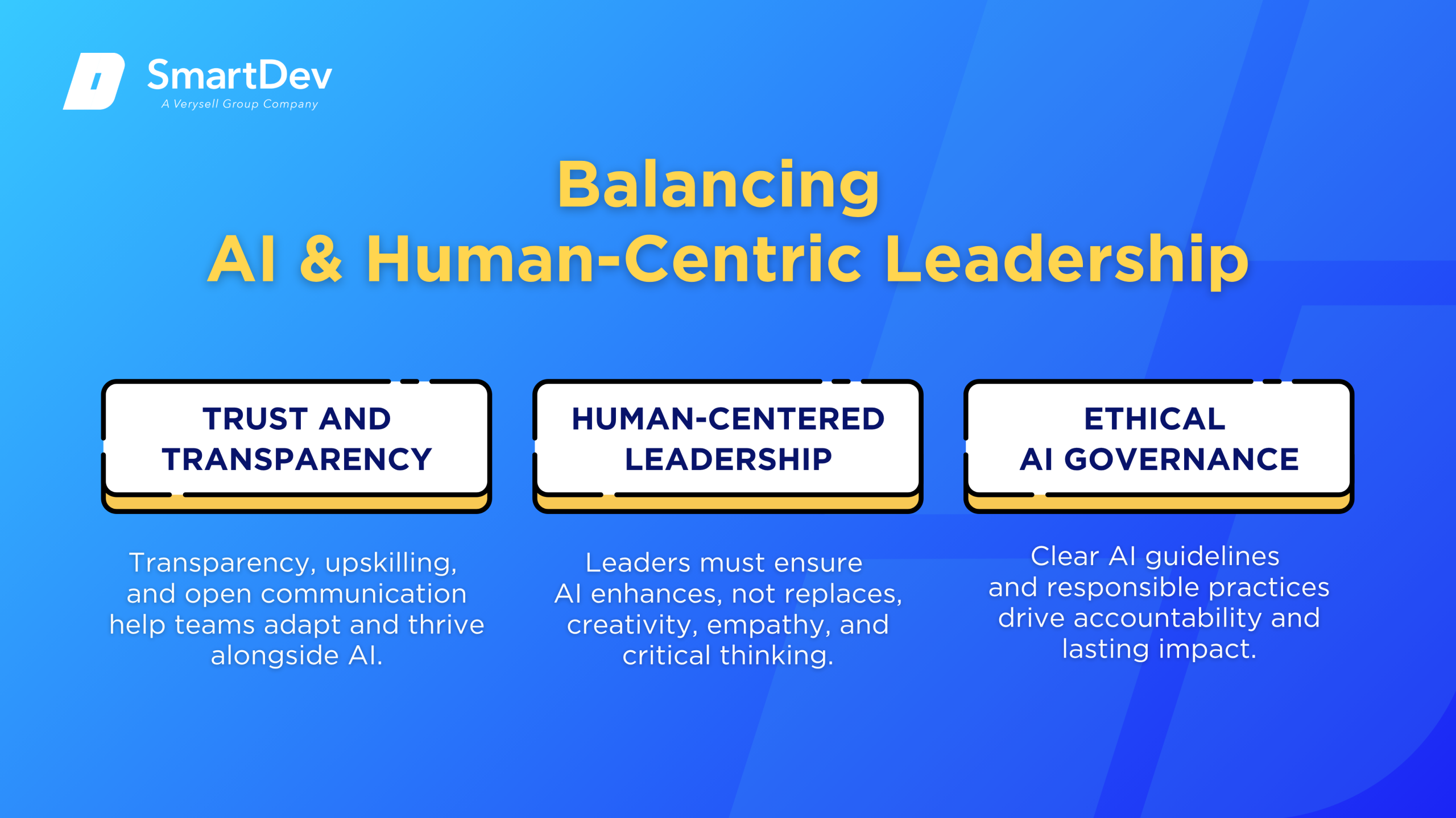
The integration of AI into the workplace is fundamentally reshaping leadership, requiring a careful balance between technological advancement and human values. Human-centric leadership emphasizes empathy, transparency, and ethical awareness, placing people – not machines – at the center of decision-making. As AI automates more tasks, leaders must ensure it enhances rather than diminishes human creativity, emotional intelligence, and critical thinking.
To maintain this balance, leaders should prioritize building trust, fostering inclusion, and communicating openly about AI’s role in the organization. Transparency around AI use, addressing employee concerns, and committing to fairness are essential for sustaining engagement and morale. Investing in upskilling initiatives is equally vital, especially in strengthening human competencies that machines cannot replicate, such as collaboration and ethical reasoning.
Establishing clear ethical guidelines for AI implementation reinforces accountability and aligns technology with organizational values. Leaders must champion responsible AI practices that prevent bias and promote transparency across all levels. By embracing both innovation and humanity, leadership can drive sustainable success in an AI-augmented future.
Measuring AI Adoption Success
For technical leaders, measuring the success of AI adoption requires a holistic approach that evaluates both model performance and system effectiveness. Core model metrics, such as accuracy, precision, and recall, help determine whether the AI is delivering reliable outputs, while operational metrics like uptime, latency, and response time ensure the system is robust and user-ready. In addition, tracking the number of models deployed and the automation level of ML pipelines offers valuable insight into scalability and deployment velocity.
Beyond technical benchmarks, it’s equally important to assess how AI is being used and the value it delivers to the business. Adoption metrics, such as user engagement, frequency of use, and satisfaction, reflect how effectively AI tools are integrated into daily workflows. To measure business impact, leaders should monitor KPIs like cost reductions, revenue gains, and productivity improvements, ensuring that AI investments translate into clear, quantifiable outcomes.
The Future of AI in Tech Leadership
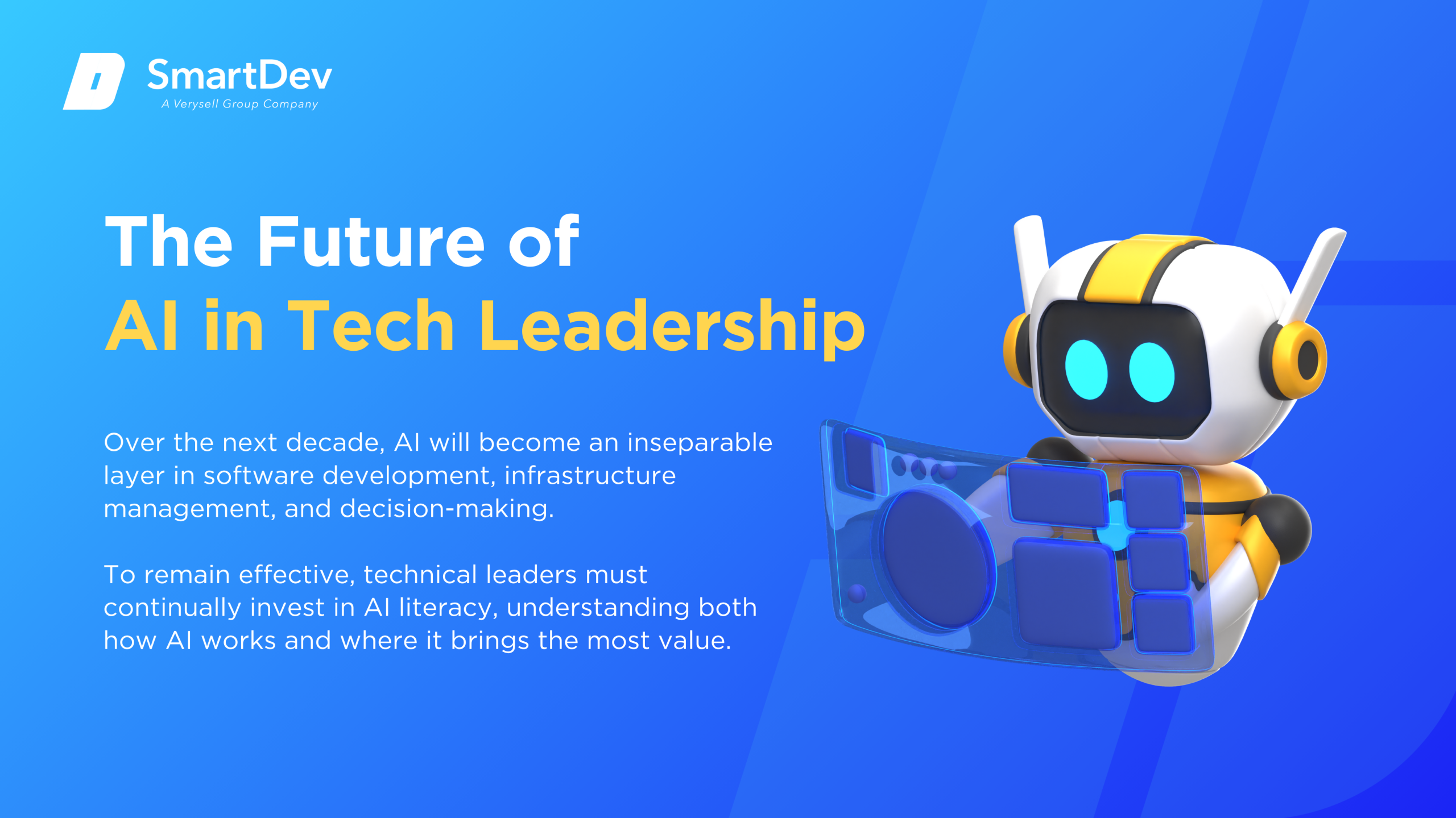
Prognosen für das nächste Jahrzehnt
Over the next decade, AI will become an inseparable layer in software development, infrastructure management, and decision-making. From autonomous code generation to intelligent team orchestration, AI will increasingly handle operational tasks, freeing leaders to focus on strategy, innovation, and human development. As AI maturity grows, leadership roles will shift from implementation oversight to ecosystem orchestration and AI governance.
Tech leadership will also evolve to include responsibility for ethical deployment, regulatory compliance, and AI workforce transformation. Leaders will be expected to guide not only technical direction but also the cultural and societal implications of AI adoption. Those who adapt will shape organizational structures, policies, and talent models built for AI-native environments.
Wie Technischer Leiter Can Stay Ahead of the Curve
To remain effective, technical leaders must continually invest in AI literacy, understanding both how AI works and where it brings the most value. This includes staying current with emerging technologies, regulatory frameworks, and AI-driven tooling that can optimize delivery pipelines. A proactive learning mindset will be essential to navigating the pace and complexity of change.
Equally important is fostering cross-functional agility by collaborating across engineering, product, legal, and HR to embed AI strategically and responsibly. Building flexible teams, upskilling talent, and cultivating a culture of experimentation will separate adaptive leaders from reactive ones. Ultimately, those who can blend technical foresight with human-centric leadership will define the next generation of innovation.
Explore the evolving AI landscape and discover the essential tools shaping tomorrow’s solutions in our detailed guide to AI Tech Stacks: The Blueprint for 2025.
Abschluss
Zusammenfassung der wichtigsten Erkenntnisse
AI is reshaping how software is developed, tested, and delivered, and with it, the expectations placed on today’s technical leaders. Embracing AI is no longer optional; it requires fluency in data, strategic thinking, cross-functional collaboration, and ethical stewardship. Successful adoption depends on a clear roadmap, strong data foundations, and a leadership mindset that balances innovation with human-centric values.
To lead in this AI-first era, engineering leaders must not only understand the technology but also champion organizational readiness, foster continuous learning, and guide teams through change. Measuring impact, both technical and business, is essential to validate progress and sustain momentum. Ultimately, those who blend technical foresight with inclusive, adaptive leadership will shape the future of intelligent engineering.
Moving Forward: A Strategic Approach to Building AI-Ready Engineering Teams
As AI transforms the software development landscape, technical leaders have a pivotal role to play in shaping teams that are not only skilled but strategically aligned with the demands of intelligent automation. From enhancing productivity through AI-assisted tools to embedding ethical decision-making into engineering workflows, building AI-ready teams is fast becoming a competitive advantage in modern tech organizations.
At SmartDev, we deliver AI-powered software development solutions that help forward-thinking companies scale innovation, streamline engineering processes, and drive lasting impact. Our tailored approach integrates AI across every phase of the software lifecycle, from code generation and testing to infrastructure optimization and delivery acceleration.
Entdecken Sie wie SmartDev’s AI-Powered Software Development services can help your team lead with intelligence.
—
Quellen:
- The state of AI: How organizations are rewiring to capture value | McKinsey & Company
- Gen AI’s ROI | McKinsey & Company
- 10 Key Findings From AWS Generative AI Adoption Index | Forbes
- Gartner Forecasts Worldwide GenAI Spending to Reach $644 Billion in 2025 | Gartner
- The CIO’s Guide to Building an AI Roadmap That Drives Value | Gartner
- Artificial intelligence implementation: 8 steps for success | IBM
- Building an AI Business Strategy: A Beginner’s Guide | Harvard Business School
- Measuring gen AI success: A deep dive into the KPIs you need | Google Cloud
- Tracking Employee AI Adoption – Which Metrics Matter | Worklytics


